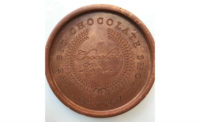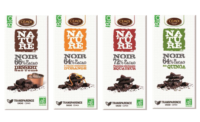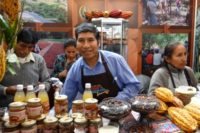
|
| From left to right: Ed Seguine (HCPI Taste Panel Chair), Daniel O'Doherty (Maunawili Experiment Station), Volker Lehmann (Alto Beni), and Dan Pearson (Co-Chair, HCPI Executive Committee) presenters and awardees at the HCPI event. Missing Lyndel Meinhardt (USDA/ARS). |
The judges’ tasting notes were effusive: “Raisins, cooked plums; candied figs and a mild pineapple; dragon fruit; star fruit; fresh fruit acidity and aromatic quality. Has some background vanilla notes.”
A description for a 95-point wine?
No, it’s for a new chocolate made from heirloom trees grown in Hawaii. In similar rhapsodic tones, the judges praised three other groups of heirloom trees from Ecuador and Bolivia as also producing exceptional fine-flavored cacao.
Premium chocolate channeling premium wine? Undeniably.
On February 11, these four heirloom groups of trees were recognized by the Fine Chocolate Industry Association (FCIA)’s Heirloom Cacao Preservation Initiative (HCPI), an international collaboration between craft, medium, and large chocolate makers and professionals and the USDA/ARS. The trees represent the first step in the Initiative’s goal of identifying and preserving the finest cacaos in the world. The trees were selected from applications submitted by growers in Bolivia, Ecuador and United States (Hawaii). Specifically:
- Alto Beni, Bolivia: Grown by Volker Lehmann of Frontier Ventures Bolivia
- Tranquilidad Estate, Beni, Bolivia: Grown by Volker Lehmann of Frontier Ventures Bolivia
- Hacienda Limon, Cotopaxi, Ecuador: Grown by Samuel Von Rutte, ORECAO SA
- Hawaii Agriculture Research Center, Maunawili Experiment Station: Harvested and processed by Daniel O’Doherty, Cacao Services Agricultural and Scientific Consulting
Unlike the best wine grapes, which have well-documented genetics, such as pinot noir which was recognized in Burgundy as early as the 4thcentury, the understanding of cacao varietals is in its infancy. Cacao farmers traditionally replant using seeds, the product of openly pollinated flowers. Such seeds germinate into plants with widely varying characteristics, much of which being undesirable. In fact, experts estimate that 80% of the harvest from these seed-planted plantations is produced by only 20% of the trees; while the majority of the trees do little but take up space.
Sometimes this diversity is beneficial to widening the gene pool; but, if propagating for preserving specific traits is desired for consistency, then side grafting is the way to go.
While grafting has become a standard practice by professional cacao plant nurseries, much of the breeders’ efforts to date have been directed at developing disease resistance and higher yields. Consideration of taste has not been the objective. The predictable result has been the proliferation of high yielding, but flavor-lacking cacao clones - like CCN 51 (Ecuador), PBC 123 (Indonesia), and PH 16 and VB 1151 (Brazil ) - the Iceberg Lettuce equivalent of the chocolate world.
Recognizing that the future of fine flavor cacao was in jeopardy, FCIA established the HCPI initiative in 2012. Its goal is “to designate, categorize, and promote the flavor and genetic profiles of heirloom cacao -- the diamond of the world’s cacao.”
Ed Seguine, chair of its tasting panel and principle of Seguine Cacao Cocoa & Chocolate Advisors; Lyndel W. Meinhardt, research leader at USDA/ARS Sustainable Perennial Crops Lab; and Dan W. Pearson, executive committee president and principle with Marañón Chocolate; represented HCPI at the press conference held in New York City last Tuesday..
The process starts with a grower submitting a sample of beans and an application to HCPI. Guittard Chocolate, this country’s oldest family-owned chocolate maker, processes the beans to a standard chocolate recipe and distributes chocolate samples to the tasting panel for blind flavor analysis. For those samples with exceptional flavor characteristics, the panel alerts the USDA to undertake genetic identification. Ultimately, these trees will be protected and propagated to insure future supplies.
“These are the flavors that we seek to preserve for humanity,” noted Seguine. “There might be dozens or hundreds of other high quality cacao out there. We have a long row to hoe before we exhaust what is potentially available.”
The HCPI tasting panel consists of seven experts, representing a combined experience factor of 210 years evaluating cocoa and chocolate. They include Ed Seguine, Gary Guittard (president of Guittard Chocolate), Chloe Doutre-Roussel (consultant, author and chocolate connoisseur), Darin Sukha (research fellow/food technologist, Cocoa Research Centre, The University of the West Indies), Jorge Redmond (president, Chocolates El Rey, Caracas, Venezuela), Martin Christy (president, Seventy% and founder of the International Chocolate Awards), and Ray Major (Cacao Fellow & Senior Manager of Sustainability Initiatives, Hershey).
So how will HCPI’s fine flavor trees save the chocolate industry?
Currently, 95% of cacao farmers produce “bulk” cocoa, the chocolate equivalent of jug wine. As international cocoa exchange pricing rules lack a price premium for fine flavor, farmers have few incentive to produce better quality cacao and, instead, chase higher yields. While cocoa bean supplies rise, farm gate cocoa prices stay relatively low, farm profitability remains marginal, and the cocoa famers’ children drift away from the farm to seek better economic opportunities elsewhere.
A similar situation struck the coffee industry. For decades, hot coffee was peddled as either regular or decaf. Farm gate bean prices were treacherously low and unstable. Then, in 1953, the Blue Mountain region in Jamaica became the first protected appellation of origin. In 1982, the Specialty Coffee Association of America was established to protect bean varietals, the craft of brewing coffee and setting quality standards. Today, there are dozens of distinctive origins, thousands of local roasters, and hundreds of thousands of local cafes to cater to knowledgeable coffee drinkers who appreciate quality and flavorful brews.
With the HCPI and other FCIA initiatives, a similar path taken by the coffee industry is being promulgated. As Seguine told the press conference attendees, “this is Quetzalcoatl’s bequest to mankind: the immense diversity of cacao, some producing unique and very intense flavor profiles.”
Fortunately, there is a growing body of Robert Mondavi-type chocolate makers capable of producing exceptional chocolate from these beans. And this pursuit of quality will save an industry driven primarily by a price-conscious mentality.
+++
Curtis Vreeland, president of Vreeland & Associates, specializes in confectionery market research. He has been spotting trends in the premium confectionery segment for Candy Industry Magazine for over half a decade. He can be reached at cvreeland@vreelandassociates.com.





